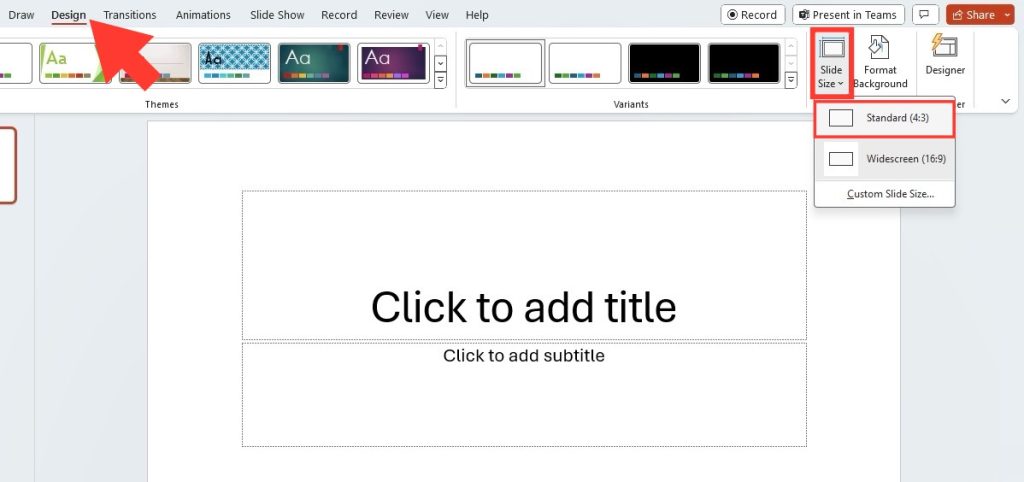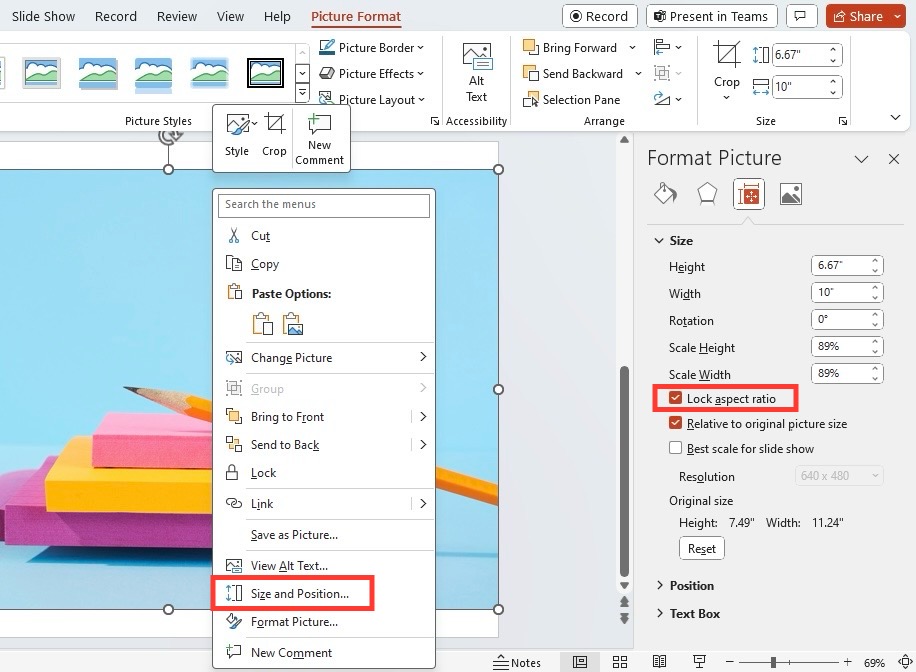

Table of Contents
Introduction to PowerPoint Slide Size
When you embark on creating a dazzling PowerPoint presentation, one fundamental element to consider is how to change the slide size. It’s like choosing the perfect canvas for your masterpiece—get it wrong, and you risk cutting off critical information or delivering a stretched and unprofessional-looking presentation.
Learn about Excel with our Free Microsoft Excel Online Course!
Key Takeaways
- To adjust the slide size in PowerPoint, first access the Design tab and then locate the Slide Size dropdown in the Customize section.
- Users can choose between Standard (4:3) and Widescreen (16:9) formats or opt for a custom size through the Slide Size dropdown menu.
- After selecting the desired slide dimensions, PowerPoint may prompt the user to scale the existing content to fit the new size; confirm the selection by clicking “OK.”
Standard vs. Custom Sizes
In PowerPoint, you have the option to select between standard and custom slide sizes. Standard typically refers to a 4:3 aspect ratio, which was the default for many years and fits well with traditional projectors and computer monitors. Widescreen, which is now often the default, boasts a 16:9 aspect ratio, aligning with modern monitors and TVs.
For something tailored, custom sizes let you specify exact dimensions. This is particularly helpful if you’re designing content for unique display systems or digital platforms with specific requirements.
Choosing between standard and custom sizes is a balancing act between compatibility with various display devices and the presentation’s intended use. With the right size, your content maintains its integrity, ensuring your audience gets the full picture—literally.
Step-by-Step Guide to Changing Slide Size
Accessing the Slide Size Settings
Changing the slide size in PowerPoint is a breeze once you know where to look. Here’s how to find those settings:
STEP 1: Open your PowerPoint presentation and make your way to the Design tab on the main menu.
STEP 2: In the Customize section, look out for the Slide Size dropdown.
STEP 3: Click on it, and a menu with several options, including Standard (4:3), Widescreen (16:9), and Custom Slide Size will appear.
These simple steps will lead you to a path where you can mold your presentation’s canvas to the size that suits your content and audience best.
Remember, if you’re all about shortcuts, Alt + G + S will be your key combo on a mission to swiftly adjust slide sizes. Sharpen your PowerPoint skills with this quick hack and save precious time!
Choosing Between Predefined and Custom Dimensions
When deciding on the perfect dimensions for your PowerPoint slides, you can either go with the flow and select a predefined size or get creative and choose custom dimensions. Here’s how to choose:
Tips for Selecting the Right Slide Size
Considerations for Different Display Devices
When selecting the right slide size, it’s crucial to consider the diverse range of devices your audience might use. From massive projection screens to tiny smartphone displays, each device interacts with slide dimensions differently.
- Projectors: Typically pair well with the standard 4:3 ratio, but newer models may cater to widescreen.
- Monitors and TVs: Modern screens are generally widescreen. Go for 16:9 here.
- Tablets and Smartphones: Landscape-oriented presentations work better, but remember users might flip their devices.
To ace device compatibility, imagine your presentation on different screens. Anticipate your audience’s viewing context and pick a size that’s a jack of all trades, masterfully displaying on all.
Remember, you can’t anticipate every device, but if you’re privy to the main screen, tailor to that. If not, widescreen is typically a safe bet in today’s high-definition world.
Impact of Slide Size on Content Layout
Choosing a slide size isn’t just about fitting the screen. It also dramatically affects your content layout. Here’s why it matters:
- 4:3 Ratio: Offers more vertical space, which is excellent for bullet-heavy, text-based slides.
- 16:9 Ratio: Provides a broader, cinematic feel, perfect for visuals and less crowded content.
Always keep in mind your message and content type when settling on a slide size. The right ratio will support your narrative and make your slides look intentional and professionally curated.
Troubleshooting Common Slide Adjustment Issues
Resizing Without Distorting Content
“No stretch marks, please!” Resizing your slides should preserve your content’s look and feel. To avoid distortion:
- Maintain aspect ratio: When adjusting sizes, ensure objects scale proportionately.
- Use high-resolution images: These can handle resizing better without losing quality.
- Lock object proportions: Before resizing, right-click on objects, and set them to maintain aspect ratio.
It’s like being a PowerPoint chiropractor—aligning everything for a perfect, non-distorted fit.
Dealing with Slide Backgrounds and Themes
Now, your slide backgrounds and themes—they’re like the outfit for your presentation. If the size changes, the outfit should too, without looking like it shrunk in the wash or was borrowed from a giant. Here’s how to keep your presentation’s design sharp:
- Background graphics: Ensure they are high-res and extend well beyond the largest slide size you plan to use.
- Theme elements: Check that any design elements are flexible enough to adjust to new sizes without losing their visual impact.
With these savvy moves, you can resize slides without your background screaming, “This doesn’t fit!
FAQ Section
What is the default slide size in PowerPoint? The default slide size in PowerPoint is typically set to the widescreen format, 16:9 aspect ratio. This size fits most modern monitors and projectors.
How do I change my PowerPoint presentation to widescreen? To shift your presentation to widescreen, go to the Design tab, click on “Slide Size,” and select “Widescreen (16:9)” from the dropdown menu.
Can I apply a different slide size to individual slides within a presentation? Each PowerPoint presentation can have only one slide size. To use different sizes, separate your content into distinct presentations.
Your sessions of PowerPoint mastery are now in session! With these tricks up your sleeve, gone are the days of awkwardly cropped or stretched slides. Go forth, present with confidence, and make every pixel count!
Impact of Slide Size on Content Layout
Choosing a slide size is more than a technicality; it affects how your content is perceived. Like wearing the right size outfit, your presentation needs to fit snugly into the chosen dimensions. Here’s why it’s essential to consider:
- Vertical Space vs. Horizontal Space: A 4:3 aspect ratio may be better for detailed graphs and text-heavy slides, providing more vertical space. Meanwhile, 16:9 gives you a wider canvas, ideal for eye-catching visuals and less crammed horizontal elements.
- Visual Clarity: The wrong size could lead to squished images or stretched text, making your slide difficult to read and easy to dismiss.
Before you set your heart on a slide size, draft your layout first. It will guide you toward a size that complements your content and makes it shine.
Resizing Without Distorting Content
Avoid the heartache of skewed images and wonky text when you resize your slides. To preserve the integrity of your content:
- Always check the “Lock aspect ratio” option for images and shapes, to retain proportions during resizing. To do this, right-click on the image, click on “Size and Position…”, then make sure to tick the box for Lock aspect ratio.
- Revisit your font sizes and adjust if necessary, as changing slide dimensions can alter text readability.
- Realign your content, ensuring it’s centered and evenly distributed across the new slide size for a polished look.
Here’s a comforting thought: your messages and visuals won’t be compromised with a bit of careful tweaking. Keeping content proportional means professionalism all the way.
And, if you’re feeling stuck, remember that tools like Knockout Prezo’s free resize tool handle the technical parts, allowing you to focus on making your content pop!
Dealing with Slide Backgrounds and Themes
Adaptation is key when resizing PowerPoints, especially when it comes to backgrounds and themes. Here’s how to maintain style and brand consistency:
- High-Resolution Backgrounds: Always use high-quality images so they don’t pixelate when stretched to fit larger dimensions.
- Flexible Themes: Opt for themes that adapt well to different sizes. Some may have scalable elements that resize without ruining the design.
Remember that your theme sets the tone for your presentation. Ensuring it scales correctly across different slide sizes not only is visually appealing but also communicates professionalism.
By giving thought to your themes and backgrounds as you resize, you’ll keep your presentation’s visual appeal as sharp on screen as it is in your mind.
What is the default slide size in PowerPoint?
The default slide size in PowerPoint for versions from 2013 onward is typically Widescreen (16:9), ideal for modern displays like HD monitors and projectors.
How do I change my PowerPoint presentation to widescreen?
To switch to widescreen, click the “Design” tab, select “Slide Size,” and choose “Widescreen (16:9)” from the menu. Your presentation will adjust to the new format.
Can I apply a different slide size to individual slides within a presentation?
Unfortunately, PowerPoint does not support multiple slide sizes within a single presentation. You need to stick to one size for all slides.


John Michaloudis is a former accountant and finance analyst at General Electric, a Microsoft MVP since 2020, an Amazon #1 bestselling author of 4 Microsoft Excel books and teacher of Microsoft Excel & Office over at his flagship MyExcelOnline Academy Online Course.









